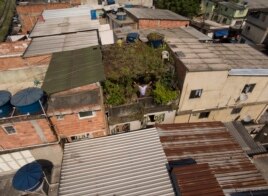29 January 2020
Recently, Alê Roque walked among a group of trees that she helped plant last year in the Brazilian city of Rio de Janeiro.
The small piece of land is near Providencia. It is Rio de Janeiro's first poor neighborhood, known in Brazil as a favela. There, homes lie close to one another. Bullet holes suggest the presence of violence.
The green area is a kind of garden. It is one of many places where trees are making the city of Rio greener.

In this Jan.10, 2020 photo, Luis Cassiano shows his green roof at his home in Arara Park favela, Rio de Janeiro, Brazil. "I think people will, one day, really wind up joining. We'll need it. Just look at the heat of all those roofs together!" (AP Photo/Renato Spyrro)
"This is cacao, developing well...Look at this lime tree, it's full...Lots and lots of tomato...," Roque said.
As she walked, she saw a yam, and reminded herself to pick it with the children that she teaches to garden.
In addition to providing free food to residents, the small piece of land provides something else. It is cooler in the shade — something rare in this part of the city, far from the sea breeze of Copacabana and Ipanema.
The activist group Catalytic Communities has mapped sustainable projects across Rio de Janeiro. Theresa Williamson, the group's executive director, said there are more and more new green projects. "There seems to be now, all of a sudden, in the last six months even, a growth in interest," she said.
Rio is famous for its coastal forests. But Rio's dense neighborhoods have little plant life.
Around 80 neighborhoods have less than 1 percent tree cover. Most are in the industrial North Zone. Without shade, these so-called "heat islands" make summer even hotter.
This month, the city's highest temperatures reached around 40 degrees Celsius.
People in Rio also talk about the "apparent temperature," a measure that includes wind and humidity. That number reached as high as 54.8 degrees Celsius on January 11.
Washington Fajardo is a visiting housing policy researcher with Harvard University. He said green projects represent a break with Rio's recent past.
Fajardo also is the former mayor's special advisor on urban issues. He told Associated Press reporters, "To get a tree to grow in an urban environment requires irrigation, because pollution makes it much harder for a sapling to reach adulthood. We knew how to do that better at the start of the 20th century than we do today, strangely."
Cecilia Herzog is the president of Inverde, an organization that researches nature and urban structures. She said Rio's public policy for green spaces is far behind the policies of other major cities. So people are taking matters into their own hands, she said.
The city has begun paying attention. Rio this month started planting native trees to create 25 "fresh islands" in the city's West Zone.
In the Providencia neighborhood, Alê Roque irrigates her plants and teaches young people how to compost.
Roque argues that if children spend their days surrounded only by alleys, bullets, and trash, they will struggle to do good in the world. They need places to play and pick flowers, she said.
"How are you going teach kids about Mother Nature if they don't have contact with it?" said Roque. "This could be happening in places all over the world, in other favelas, other little areas."
Why does Roque work so hard in the heat?
"I want to make the world green!" she said and laughs, then collects herself. "It's because someone has to do it, truthfully that's it. Someone has to do it."
I'm John Russell.
David Biller reported on this story for the Associated Press. John Russell adapted it for Learning English. Mario Ritter, Jr. was the editor.
________________________________________________________________
Words in This Story
breeze – n. a gentle wind
sustainable – adj. involving methods that do not completely use up or destroy natural resources; able to be used without being completely used up or destroyed
humidity – n. moisture in the air
irrigation – n. the act of supplying (something, such as land) with water by using artificial means (such as pipes)
sapling – n. a young tree
interior – n. an inner part, area, or surface
compost – v. to change (plant materials) into compost
endure – v. to experience (difficulty, pain or suffering) for a long time
We want to hear from you. Write to us in the Comments Section.